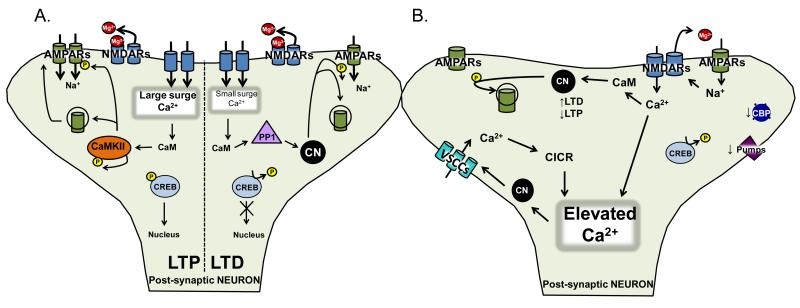Figure 1.
A. Synaptic Plasticity. Long-term potentiation (LTP) and long-term depression (LTD) involve the activation of two glutamate receptors, α-amino-3-hydroxy-5-methylisoxazole-4-propionic acid receptors (AMPARs; green) and and N-methyl-D-aspartic acid receptors (NMDARs; blue). Both are permeable to Na+ and K+, while a subgroup of AMPARs and all NMDARs are permeable to Ca2+. Upon membrane depolarization by AMPARs, NMDARs expel a Mg2+-block (red), and permit Ca2+ entry into the postsynaptic cell. Both forms of plasticity require Ca2+ influx through NMDARs, though LTP generally requires a large surge in postsynaptic Ca2+, and LTD generally requires smaller Ca2+ influxes. As a result, the differing Ca2+ signals activate divergent biochemical cascades. Protein kinases, especially Ca2+/calmodulin-dependent protein kinase II (CaMKII; orange oval), have been strongly implicated in LTP, where they are involved in the phosphorylation (small yellow circle) and subsequent membrane insertion of glutamate receptors. Smaller elevations in Ca2+ are involved in LTD induction and activate protein phosphatases, namely Ca2+/calmodulin dependent protein phosphatase, calcineurin (CN; black circle), and/or protein phosphatase 1 (PP1; lavender triangle), which can be stimulated by CN activity. The balance in activity of protein kinases and phosphatases regulates the magnitude/duration of synaptic changes, and helps maintain the functional status of the synapse under basal conditions.
B. Ca2+ dysregulation. Synaptic plasticity requires the activation of the appropriate biochemical cascades, and exquisite Ca2+ regulation. Under normal conditions, there are numerous mechanisms regulating intracellular Ca2+ concentrations. These include: voltage sensitive Ca2+ channels (VSCCs; aqua), a variety of receptors on the cell surface (NMDARs; light blue) or receptors on intracellular organelles which store Ca2+ (IP3Rs and ryanodine receptors), pumps (SERCA Ca2+; purple), binding proteins (calreticulin, BiP/grp78, grp94, and calnexin; royal blue), and intracellular organelles which store Ca2+ (endoplasmic reticulum and mitochondria). All of these mechanisms are impaired with aging, leading to increases in Ca2+ entry/release, and decreased Ca2+ expulsion/sequestration, leading to an elevation in Ca2+ concentration.

